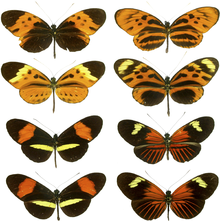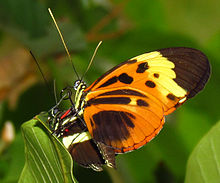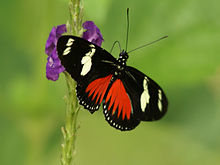- Heliconius
-
Not to be confused with Heliconia.
- "Crenis" redirects here. As described by Boisduval in 1833, this is an invalid name of the brush-footed butterfly genus Sevenia.
Heliconius 
Forms of Heliconius numata, H. melpomene and H. erato Scientific classification Kingdom: Animalia Phylum: Arthropoda Class: Insecta Order: Lepidoptera Division: Rhopalocera Family: Nymphalidae Subfamily: Heliconiinae Genus: Heliconius
Kluk, 1780Type species Heliconius charithonia
Linnaeus, 1767Species About 39, see species list in text.
Synonyms Ajantis Hübner, 1816
Apostraphia Hübner, 1816
Blanchardia Buchecker, 1880 non Castelnau, 1875: preoccupied)
Crenis Hübner, 1821
Heliconia Godart 1819
Migonitis Hübner, 1816 (non Rafinesque, 1815: preoccupied)
Phlogris Hübner, 1825
Podalirius Gistel, 1848
Sunias Hübner, 1816
Sicyonia Hübner, 1816Heliconius comprise a colorful and widespread brush-footed butterfly genus distributed throughout the tropical and subtropical regions of the New World. These butterflies utilize Passion flower plants as their larval food source and rely on bright wing color patterns to signal their distastefulness to potential predators (aposematism). Heliconius butterflies have been a subject of many studies due to their abundance and relative ease in breeding under laboratory conditions, as well as due to the extensive mimicry that occurs in this group. Studying this model group is helping scientists to understand how species are formed and why they are so diverse. They are usually unpalatable and are models for Müllerian mimicry by unrelated butterflies. Heliconius butterflies benefit from mimicking other unpalatable species of butterfly because doing so spreads the cost of educating predators. Hybrid speciation has been hypothesized to occur in this genus and may contribute to the diverse mimicry found in Heliconius butterflies. The data supporting this idea are reviewed and critiqued in.[1]
Contents
A Model for Evolutionary Study
Convergence
The Heliconius butterflies are the subjects of years of research due to the existence of Müllerian mimicry rings between species. Mimicry in Heliconius is an example of convergent evolution. Recent work has focused on understanding the genetic changes responsible for the convergent evolution of wing patterns in comimetic species. Molecular work on two distantly related Heliconius comimics, Heliconius melpomene and Heliconius erato, has revealed that homologous genomic regions in the species are responsible for the convergence in wing patterns.[2][3][4]
Speciation
Heliconius butterflies are also models for the study of speciation. It has been proposed that two closely related species, H. cydno and H. melpomene, hybridized to create the species H. heurippa. Assortive mating reproductively isolates H. heurippa from its parental species.[5] This is considered by some to represent a rare example of speciation through hybridization in animals (but see reference [1], below).
Species
Most current researchers agree that there are some 39 Heliconius species. These are listed alphabetically here, according to Gerardo Lamas' (2004) checklist.[6] Note that the subspecific nomenclature is incomplete for many species (there are over 2000 published names associated with the genus, many of which are subjective synonyms or infrasubspecific names).[7][8][9]
- Heliconius Kluk, 1802
- Heliconius antiochus (Linnaeus, 1767) – Antiochus Longwing
- Heliconius astraea Staudinger, 1897
- Heliconius atthis Doubleday, 1847 – Athis Longwing or False Zebra Longwing
- Heliconius beskei Ménétriés, 1857
- Heliconius burneyi (Hübner, 1816) – Burney's Longwing
- Heliconius charithonia (Linnaeus, 1767) – Zebra Longwing
- Heliconius clysonymus Latreille, 1817 – Clysonymus Longwing
- Heliconius congener Weymer, 1890
- Heliconius cydno (Doubleday, 1847) – Cydno Longwing
- Heliconius demeter Staudinger, 1897
- Heliconius egeria (Cramer, 1775)
- Heliconius eleuchia Hewitson, 1853 – Eleuchia Longwing
- Heliconius elevatus Nöldner, 1901
- Heliconius erato (Linnaeus, 1764) – Crimson-patched Longwing, Red Postman
- Heliconius ethilla (Godart, 1819) – Ethilia Longwing
- Heliconius hecale (Fabricius, 1775) – Tiger Longwing or Hecale Longwing
- Heliconius hecalesia Hewitson, 1853 – Five-spotted Longwing
- Heliconius hecuba (Hewitson, [1858])
- Heliconius hermathena (Hewitson, 1853) – Hermathena Longwing
- Heliconius heurippa (Hewitson, 1853)
- Heliconius hewitsoni Staudinger, 1875
- Heliconius hierax Hewitson, 1869
- Heliconius himera Hewitson, 1867
- Heliconius hortense Guérin, [1844] – Mexican Longwing or Mountain Langwing
- Heliconius ismenius Latreille, [1817] – Ismenius Tiger or Tiger Helconian
- Heliconius lalitae Brévignon, 1996
- Heliconius leucadia (Bates, 1862) – Leucadia Longwing
- Heliconius melpomene (Linnaeus, 1758) – (Common) Postman
- Heliconius nattereri Felder, 1865 – Natterer's Longwing
- Heliconius numata (Cramer, 1780) – Numata Longwing
 Numata Longwing (Heliconius numata)
Numata Longwing (Heliconius numata)
- Heliconius pachinus Salvin, 1871 – Pachinus Longwing
- Heliconius pardalinus (Bates, 1862)
- Heliconius peruvianus Felder – Peruvian Longwing
- Heliconius ricini (Linnaeus, 1758) – Ricini Longwing
- Heliconius sapho (Drury, 1782) – Sapho Longwing
- Heliconius sara (Fabricius, 1793) – Sara Longwing
 Sara Longwing (Heliconius sara)
Sara Longwing (Heliconius sara)
- Heliconius sergestus (Weymer, 1894)
- Heliconius telesiphe Doubleday, 1847 – Telesiphe Longwing
- Heliconius timareta (Hewitson, 1867)
- Heliconius tristero Brower, 1996
- Heliconius wallacei Reakirt, 1866 – Wallace's Longwing
- Heliconius xanthocles Bates, 1862
Sometimes placed in Heliconius:
- Laparus doris (Linnaeus, 1771) – Doris Longwing
References
- ^ Brower AVZ (2011). "Hybrid speciation in Heliconius butterflies? A review and critique of the evidence". Genetica 139 (2): 589–609. doi:10.1007/s10709-010-9530-4.
- ^ Baxter, S. W., R. Papa, N. Chamberlain, S. J. Humphray, M. Joron, C. Morrison, R. H. Ffrench-Constant et al. 2008. Convergent evolution in the genetic basis of müllerian mimicry in heliconius butterflies. Genetics 180:1567-1577
- ^ Counterman, B. A., F. Araujo-Perez, H. M. Hines, S. W. Baxter, C. M. Morrison, D. P. Lindstrom, R. Papa et al. 2010. Genomic hotspots for adaptation: The population genetics of Müllerian mimicry in heliconius erato. Plos Genetics 6:-.
- ^ Joron, M., R. Papa, M. Beltran, N. Chamberlain, J. Mavarez, S. Baxter, M. Abanto et al. 2006. A conserved supergene locus controls colour pattern diversity in heliconius butterflies. Plos Biology 4:1831-1840
- ^ Mavarez, J., C. A. Salazar, E. Bermingham, C. Salcedo, C. D. Jiggins, and M. Linares. 2006. Speciation by hybridization in heliconius butterflies. Nature 441:868-871.
- ^ Lamas, G., Ed. (2004) Atlas of Neotropical Lepidoptera. Checklist: Part 4A Hesperioidea - Papiionoidea. Gainesville, Scientific Publishers/Association of Tropical Lepidoptera.
- ^ Heliconiini, Nymphalidae Study Group website
- ^ Heliconius, funet.fi
- ^ Heliconius, Neotropical Butterflies
- Holzinger, H. & R. (1994). Heliconius and related genera. Sciences Nat, Venette, pp. 1–328, pl. 1-51 [1]
- Kapan, D.D. (2001). Three-butterfly system provides a field test of Müllerian mimicry. Nature, 409, 338-340.
- Kronforst, M.R.; Young, L.G.; Blume, L.M.; and Gilbert, L.E. (2006). Multilocus analyses of admixture and introgression among hybridizing Heliconius butterflies. Evolution, 60, 1254-1268.
- Mallet, J.; Beltrán, M.; Neukirchen, W.; & Linares, M. (2007). Natural hybridization in heliconiine butterflies: The species boundary as a continuum. BMC Evol Biol, 7, 28-28. abstract
External links
Categories:- Heliconiini
- Heliconius
Wikimedia Foundation. 2010.


